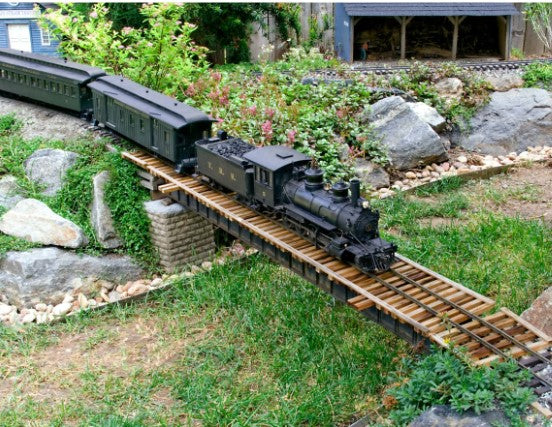Check out detailed garden railroad build guides at shop.trains.com.
Garden railroading is a popular subsection of the model railroading hobby, and for good reason. One of the most limiting factors for building a functional track or train station is available space. Many people don’t have one or more entire rooms to spare for a model railroad build. Garden railroading, however, takes that build and reimagines it outside, where you’re much more likely to find the necessary square footage (or acreage!) for a satisfying modeling experience.
Of course, garden railroading also takes advantage of the naturally occurring terrain in your area to complete the backdrop for your track. Instead of simulating an outdoor backdrop in your home, you can simply stage your existing property to achieve the aesthetic you’re after!
To get started on your garden railroad build, here are some helpful steps to consider:
Layout

Before you decide on scale, era, or models you want to use, you’ll want to know the space you have to work with and what hardware will work best for your terrain. It’s ultimately up to you what level of detail you want in your setup, but every landscape has its limitations.
It’s likely that you’ll have obtrusive structures or anachronistic imagery somewhere in your preferred location. Even if you’re able to find space out of sight of any buildings, you may have to work around power lines, drainage, road signs, or any number of other hazards.
To decide what type railroad you want to build, especially if you want to do a recreation of a real-world station or railyard, you need to understand what type of vegetation, geography, and even geology you have to work with, as you’ll want to avoid the graveyard effect – the appearance of disjointed and unnatural elements in the scenery.
Research
Most garden railroad setups tend to be recreations of real-life locations. Once you know where you want to create your build, you’ll need to study track arrangements (such as how turnouts, crossings, and sidings function), maps and diagrams of the station you want to emulate, and of course photographs of historical or modern sections of track.
Scale

Most garden railroads, like indoor model setups, use HO scale. With additional outdoor real estate, however, you may find that the larger O gauge scale is easier to work with and more realistic when adding plants, structures, rocks, and other landscaping elements.
Whatever you choose to build with, stay consistent and use your reference materials to create the look and feel you’re after.
Set Pieces
There are numerous guides for how to stage your garden railroad, like this one and many more at trains.com. Whether you’re recreating a real-life location or building a fantasy landscape, or something in between, you’ll want your tracks and your station to feel complete with lifelike landscaping, structures (including bridges, tunnels, depots, and any other appropriate man-made features), and even models of people or wildlife.

This digital download on how to build stone walls and bridges gives an in depth guide to help you get started with practical modeling tips and tricks, and for more advanced modelers, this guide on weathering will help you create that lifelike patina that gives your build an authentic aesthetic. Depending on how extensive your plans are, you’ll also want to check out these downloads on garden track power mechanics and coupler basics.
Whatever your skill level and however ambitious your plans are for garden railroading, you can find specific, helpful instructional manuals at shop.trains.com.
Still need more help on where to start? Thankfully, the model train community is chock full of talented and helpful folks with years of experience. Join the Classic Toy Trains Forum and see what members are saying about their builds.
- Written by Matt Herr

